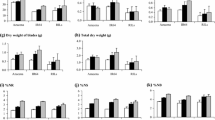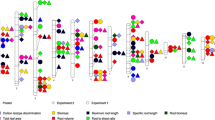Abstract
An F2 population, consisting of 231 individuals derived from a cross between rice cultivars with a similar growing duration, Palawan and IR42, was utilized to investigate the genetic nature of rice varietal ability to stimulate N2 fixation in the rice rhizosphere. To assess rhizospheric N2 fixation, an isotope-enriched 15N dilution technique was employed, using 15N-stabilized soil in pots. IR42, an indica variety, had 23% higher N derived from fixation (Ndfa) than Palawan, a javanica genotype. Normal segregation of atom% 15N excess was obtained in the F2 population, with an average of 0.218 with 8% of plants below IR42 (0.188) and 10% of plants above Palawan (0.248). One-hundred-and-four RFLP markers mapped on 12 chromosomes were tested for linkage to the putative QTLs. Significant (P<0.01) associations between markers and segregation of atom% 15N excess were observed for seven marker loci located on chromosomes 1, 3, 6 and 11. Four QTLs defined by the detected marker loci were identified by interval-mapping analysis. Additive gene action was found to be predominant, but for at least one locus, dominance and partial dominance effects were observed. Significant (P<0.01) epistatic effects were also identified. Individual marker loci detected between 8 and 16% of the total phenotypic variation. All four putative QTLs showed recessive gene action, and no phenotypic effects associated with heterozygosity of marker loci were observed. The results of this study suggest that rice genetic factors can be identified which affect levels of atom% 15N excess in the soil by interacting with diazotrophs in the rice rhizosphere.
Similar content being viewed by others
References
App AA, Watanabe I, Ventura TS, Bravo M, Jurey CD (1986) The effect of cultivated and wild rice varieties on the nitrogen balance of flooded soil. Soil Sci 141:448–452
Buresh RJ, Austin ER, Craswell ET (1982) Analytical methods in 15N research. Fertil Res 3:37–62
Causse M, Fulton TM, Cho YG, Ahn SN, Chunwongse J, Wu K, Xiao J, Yu ZH, Ronald PC, Harrington SB, Second GA, McCouch SR, Tanksley SD (1994) Saturated molecular map of the rice genome based on an inter-specific backcross population. Genetics 138: 1251–1274
Champoux MC, Wang G, Sarkarung S, Mackill DJ, O'Tool JC, Huang N, McCouch SR (1995) Locating genes associated with root morphology and drought avoidance in rice via linkage to molecular markers. Theor Appl Gene 90:969–981
Dommergues YR (1978) Impact on soil management and plant growth. In: Dommergues YR, Krupa SV (eds) Interactions between non-pathogenic soil microorganisms and plants, pp 443–458, Elsevier, Amsterdam
Edwards MD, Stuber CW, Wendel JF (1987) Molecular-marker-facilitated investigation of quantitative trait loci in maize. I. Number, genetic distribution and types of gene action. Genetics 113:115–125
Feinberg AP, Vogelstein B (1984) A technique for radiolabelling DNA restriction fragments to a high specific activity. Anal Biochem 132:6–13
Iyama, S, Sano Y, Fujii T (1983) Diallel analysis of nitrogen fixation in the rhizosphere of rice. Plant Sci Lett 30:427–135.
Ladha JK (1986) Studies on N2 fixation by rice plant-associated bacteria in wetland rice field. Bionature 6:47–58
Ladha JK, Padre AT, Punzalan GC, Watanabe I, De Datta SK (1988) Ability of wetland rice to stimulate biological nitrogen fixation and utilize soil nitrogen. In: Bothe H, Bruijin FJ, Newton WE (eds) Nitrogen fixation: hundred years after. Gustav Fischer, Stuttgart, New York, pp 747–752
Ladha JK, Padre AT, Reddy K and Ventura W (1993) Prospects and problems of biological nitrogen fixation in rice production: a critical assessment. In: Palacios R et al. (eds) New horizons in nitrogen fixation. Kluwer Academic Publishers, Netherlands, pp 677–682
Lander ES, Botstein D (1989) Mapping Mendelian factors underlying quantitative traits using RFLP linkage maps. Genetics 121:185–199
Lander ES, Green P, Abrahamson J, Barlow A, Daly MJ, Lincoln SE, Newburg L (1987) MAPMAKER: an interactive computer package for constructing primary genetic linkage maps of experimental and natural populations. Genomics 1:174–181
Lin M, You CB (1989) Root exudates of rice (Oryza sativa L.) and their interaction with Alcaligenes faecalis (English abstract). Sci Agric Sinica 22:6–12
Nakagahra M (1972) Genetic mechanism of the distorted segregation of marker genes belonging to the eleventh linkage group in cultivated rice. Jpn J Breed 22:232–238
Neyra CA, Hageman RH (1978) Relationships between carbon dioxide, malate and nitrate accumulation and reduction in corn (Zea mays L.) seedlings. Plant Physiol 58:726–730
Pareek RP, Ladha JK, Watanabe I (1990) Estimation of N2 fixation by Sesbania rostrata and S. cannabina in lowland rice soil by the 15N dilution method. Biol Fertil Soils 10:77–88
Rarivoson C, Ladha JK (1992) Estimation of N2 fixed by stem- and root-inoculated Sesbania rostrata using 15N enrichment of soil ammonium-N as a reference. Biol Fertil Soils 13:74–78
Rennie RJ, Rennie BA, Fried M (1978) Concepts of 15N usage in dinitrogen fixation studies. (IAEA-AG-92/7). In: Isotopes in biological dinitrogen fixation. International Atomic Energy Agency, pp 107–120
Roger PA, Ladha JK (1992) Biological nitrogen fixation: investment, expectations and actual contributions to nitrogen balance. Plant and Soil 141:41–58
Stuber CW, Edwards MD, Wendel JF (1987) Molecular-marker-facilitated investigation of quantitative trait loci in maize. II. Factors influencing yield and its component traits. Crop Sci 27:639–648
Vancura V (1964) Root exudates of plants. Plant and Soil 21:231–248
Ventura W, Watanabe I (1983) 15N dilution technique of assessing the contribution of nitrogen fixation to rice plants. Soil Sci Plant Nutrit 29:123–131
Wang GL, Mackill D, Bonman JM, McCouch SR, Champoux MC, Nelson RJ (1994) RFLP mapping of genes conferring complete and partial resistance to blast in a durably resistant rice cultivar. Genetics 136:1421–1434
Watanabe I, Ito O, Barraquio W (1981) Nitrogen-fixing population and activity associated with wetland rice. In: Vose PB, Rusche AP (eds) Associative N2-fixation, vol 2. CRC Press, Florida, pp 177–182
Watanabe I (1991) Errors related to the 15N dilution method to estimate nitrogen fixation. In: Staple isotopes in plant nutrition, soil fertility and environmental studies. International Atomic Energy Agency, Vienna, pp 83–88
Wu P (1993) Screening criteria for evaluating the efficiency of nitrogen use in rice and genetic backgrounds of rice-bacterial associated N2 fixation. PhD thesis. University of Philippines, Los Banos, Philippines
Author information
Authors and Affiliations
Additional information
Communicated by G. S. Khush
Rights and permissions
About this article
Cite this article
Wu, P., Zhang, G., Ladha, J.K. et al. Molecular-marker-facilitated investigation on the ability to stimulate N2 fixation in the rhizosphere by irrigated rice plants. Theoret. Appl. Genetics 91, 1177–1183 (1995). https://doi.org/10.1007/BF00220926
Received:
Accepted:
Issue Date:
DOI: https://doi.org/10.1007/BF00220926




